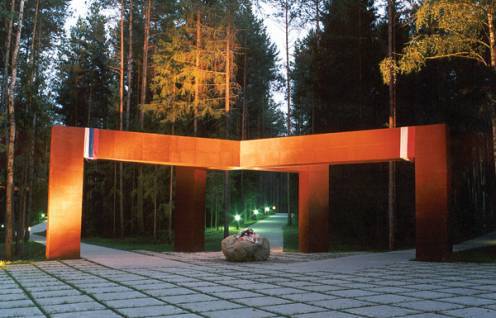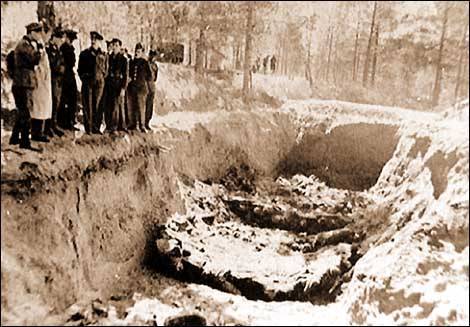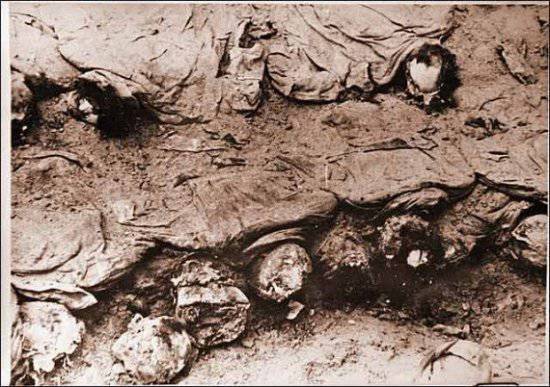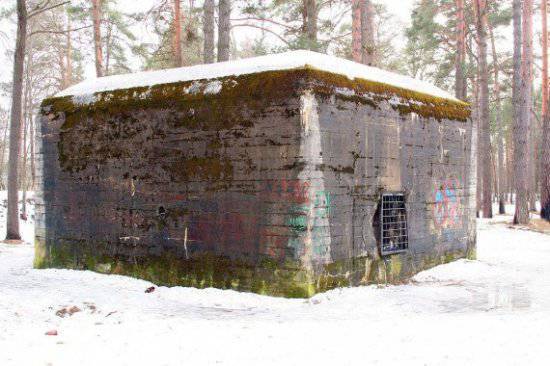"Berenhalle" - Katyn clue

The circumstances of the death of Polish officers, who were buried in the notorious Katyn Forest, were never a secret for the people of Smolensk. But these people were not at all silent, for this they never had any reason or reason. Just nobody asked them and, moreover, did not publish their memories.
My childhood was spent on the outskirts of Smolensk, precisely in those places that are currently overgrown with a huge amount historical speculation. And I remember very well what former partisans or those who simply survived the period of occupation spoke about in those years.
At the end of 1950 and the beginning of 1960, hardly anyone would have thought that, sitting on the bench in the evening, talking about the war would have been worth it, as they say, on record. And after many years this record could have put an end to a dirty business of international scope.
But no, in those years, no one thought about it. Although the survivors of the war knew very well: both Polish officers and Soviet prisoners of war worked on the construction of Hitler’s bunker near Smolensk, in the Krasny Bor forest area. After completion of the work, both were destroyed.

Version vs version
In February-April, the 1943 of the year in the Smolensk region began a series of strange and completely uncharacteristic events. In fact, it is difficult to imagine that on the days of the end of the Battle of Stalingrad and the hardest battles near Kharkov, the top leadership of the Reich did not find for themselves more important things than excavating some graves in a separate section of a long-occupied territory.
War is war, and the case was delivered in a big way. Here and the arrival in the cold Smolensk forests of a specially formed Polish delegation with the participation of a specially trusted "writer", F. Getla, who was then honored to be the first to make a radio message saying that it was the Russians who killed the Polish officers. Here and the leadership of the excavation of the famous German professor G. Butz, and a whole international forensic experts brought not only from the countries occupied by the Germans, but even from Switzerland ...
This representative delegation investigated (or simply inspected, it is impossible to establish with accuracy) nine corpses and signed a protocol, which was published in Volkisher Beobachter in early May.
According to the German version, Polish officers were shot in March 1940 of the year after they were sentenced by the “special troop of the NKVD” * to the death penalty. But here's a strange thing: the “protocol” contains details that medical experts could not establish in any way, even with all the desire and the highest qualification. Well, for example, whence to the luminaries of medicine to know that Polish officers were taken in small batches to Gnezdovo station, west of Smolensk, where they were transplanted into a bus with shaded windows, and then this bus took prisoners to a shed in Kozi Gory, this is a wooded area in the dacha suburb of Smolensk. Did they see it with their own eyes? And the “bus from 1940 of the year”, and its “painted glass”, and “shed” - this is not at all on the medical side. But the protocol was signed ...
Next - a simple conclusion: about half a kilometer from the buildings of the NKVD rest home (Kozi Gory), about ten thousand people were shot on the side of the road connecting the highway and the rest home. Buried, of course, there. The Poles themselves, however, stubbornly cling to another number: four and a half thousand.
Nevertheless, not all in this version "grow together". Shooting near the existing NKVD rest home, one might say, in your own yard - this is at least idiocy. Why are there a rest house ... Goat Mountains in the pre-war period is a famous place for picnics and barbecues. There, especially on weekends, went a good half of the inhabitants of Smolensk. From the burial place of the Poles to the busy highway - two hundred meters, and to the "barbecues with barbecues" - seven hundred ... With the same chances for success today, you can organize "secret" executions and burials in Moscow, in Serebryany Bor.
According to the Soviet version, in March 1940, part of the captured Polish officers was convicted by a Special Meeting under the NKVD of the USSR and sentenced to five years of exile in correctional labor camps with deprivation of the right of correspondence. By the beginning of the war, they were in camps near Smolensk (there were three camps), building roads. It is known that during the battle for Smolensk, the Germans undertook an energetic flank maneuver and took the city from the south. Moreover, the Chekists did not take out any prisoners from the Smolensk region and did not take them out. At that moment it was technically impossible: the highways and railways were cut, and the strongest battles were going east of the camps. It is also known that a kind of rebellion arose among the prisoners when they were offered to go east on foot, in the woods. This means that the Poles consciously decided to change the Soviet camps to German ones. Okay, changed ...
Having captured the Soviet camps, the Germans became the absolute masters in them. In February-March 1942, they from various places began bringing the corpses of Polish officers to the Katyn forest and bury them in the dugs previously dug. A year later, Goebbels began his large-scale propaganda campaign.
Smolensk was liberated 25 September 1943 of the year. As the front moved back to the west, the possibility of exploring graves appeared. At the beginning of November, a Soviet commission of inquiry arrived in Katyn, which was later named after the chairman "the Burdenko commission". Until February, 1944, the commission investigated a total of 925 corpses. At the end of the investigation, foreign journalists accredited at that time in Moscow were invited to Katyn.
The findings of the commission on the unconditional fault of the Germans for the shooting of the Poles are set forth in two essentially identical documents - in an open message and in a secret reference for the management. By the way, even if we assume that the Poles were shot by the Soviet side, then why do you need to dig in the woods all winter, and also show all this to the allies? And any necessary references can be made even without leaving Moscow ...
"Mystery" in walking distance
"... In the postwar years, ridiculous rumors circulated around Smolensk that during the occupation years, a huge underground complex Berenhalle (Bear Den) was built by fascists in the outskirts of the town in the village of Krasny Bor, which was popularly called Hitler's bunker” . According to rumors, the complex consisted of an underground conference room, designed for 250 seats, a strategic communications hub, consisting of four floors that went deep underground and communicated with each other by a spiral staircase and a system of multi-kilometer tunnels leading to the Dnieper and the airfield. ”
Something like this, a few Russian media outlets are writing about The Bear Den today. Probably for them it is still "mystery" and "rumors".
But for the residents of Smolensk region there was never any secret. Everyone knew about the bunker, from young to old, and from the very beginning of construction. Even after the war, any boy could easily find and show not only massive concrete caps - the entrances to the bunker, but also approximately determine the outer boundaries of the underground structure. Moreover, for many years pioneer camps, including the camp belonging to the Smolensk aircraft plant, were located in the forest area of Krasny Bor. From the pioneer camp to the nearest armored cap was a mile and a half, through the forest; we, as schoolchildren, went there to pick blueberries every day. Such a terrible "secret".
In its form and proportions, the cap resembled a loaf of rye bread, and therefore received from us the appropriate name: “loaf”. There was only one tightly welded steel door that went out in the direction of the railway track, which was brought directly to the "loaf" (no more than a dozen steps from door to track).
Today, without much difficulty, you can find three above-ground bunkers. This exits to the surface. Each of them has his own nickname: "Round", "Hut", "Western". The entrances to the concrete structures are closed tightly.
Inside the perimeter
Construction of the bunker began in the fall of 1941. And by mid-August 1942, he was completely ready. But, as it is believed, by this time Hitler no longer needed to actively use the bunker. Although he visited the Berenhalle twice: in November 1941 and in March 1943. (The unsuccessful attempt of an assassination attempt on Hitler by a group of German generals is connected with the last visit. It is curious that this attempt and the excavations at Katyn coincide in time).
There is reliable evidence that Red Bor has repeatedly visited Guderian, Keitel, Yodel, Canaris. In these places there was a well-known intelligence school of the Abwehr "Saturn", although there is no exact information about whether any part of the Bernhalle underground structures was used in its interests.
... Judging by the far from complete German archival data, about two and a half thousand employees of the German military construction organization Todt and ... Russian civilian workers were employed in the construction of the Bear Den. Translated from the military-state language to normal, this means that the bunker was built by prisoners of war. With all the consequences for them.
Those who survived the occupation, and without archival data, knew that not only Soviet prisoners of war worked at the facility, but also the Poles, the same officers, who preferred for themselves “good” German captivity. The complete lack of information about the future fate of all these people is the very clear answer to the question of where they then went. Already today, information has leaked out that not only Soviet and Polish, but even some German construction teams were destroyed after the work was completed.
Particularly noteworthy is the strictest secrecy regime that was maintained during the construction of the Bear Den. Modern Russian "informed" media unanimously claim that the bunker was guarded by SS officers from the Dead Head division. This is ordinary journalistic nonsense. 3rd tank SS division “Dead Head” (even taking into account the two Panzergrenadier regiments “Thule” and “Theodore Eyke”) was completely designed to perform any security functions ...
Locals, including former partisans, told how everything was in reality. The underground facility had four security perimeters. The first, external perimeter was provided by the auxiliary police (traffickers). The second perimeter is the Wehrmacht infantry units periodically replacing each other. The third perimeter is SS units, apparently from Germany, not from the front. Fourth, the most important perimeter - the Finns. Yes, yes, laconic and phlegmatic guys from the country of forests and lakes. And if the locals, in general, were not particularly afraid of either the Germans or the policemen, they didn’t try to fall into the hands of the Finns under any circumstances. Phlegmatic guys were distinguished by absolute fanaticism and extreme cruelty.
The strict protection regime of the entire construction zone and adjacent territories fully extended to the so-called Katyn forest.
It is worthwhile to clarify the geographical location of Red Bor and Bear Den itself. The forest is located a few kilometers west of Smolensk, on the left bank of the Dnieper (the Vitebsk highway and the railway run parallel to the Dnieper). The Goat Mountains, the Katyn Village and the Katyn Forest are located west of Krasny Bor. Space imagery clearly shows that the distance between the borders of the Krasny Bor forest and the Katyn forest, in their modern configuration is about four kilometers. This means that during the period of the Great Patriotic War the distance “from the edge to the edge” could be much less. Therefore, shooting inside a protected area, in a nearby forest, any number of prisoners — at least Polish, even Soviet — is not a problem at all.
“Historians” from the Central Committee
Today, the Polish Katyn Memorial is a model of military burial. Well-groomed paths and monumental symbolic tombstones ... Guerrillas killed in the Smolensk region could envy such pompousness at the state level.
... At the end of the 1980's and the beginning of the 1990's a series of ritual procedures of repentance took place, the beginning of which was laid by Gorbachev. In this, Valentin Falin **, head of the international department of the CPSU Central Committee, played along with this. In fact, his role became key in this story: it was this doctor of historical sciences who readily reported to the footman Gorbachev that "the NKVD killed the Poles." And Attorney General Trubin, with the same readiness, “waved it all”.
So flourished historic sprawling cranberry called "Katyn case."
And the investigation in our time? And if by all the rules? He simply did not exist. And it's not just in a hurry. Any serious investigation involves the strict observance of the necessary investigative procedures under the law. Yes, there were some excavations, but it was “some”. The investigative procedures did not even smell there. And this is in a situation where the “Gorbachev team” and the Polish side were most interested in the “promotion” of the case.
Not logical turns out. With such a degree of political interest, it was possible to attract any number of competent investigative specialists in order to once and for all secure our own “correct” version of events. But it seems that the “historians” of the Central Committee of the CPSU knew: there was simply nothing to fix in the Katyn forest. Therefore, a responsible "investigation" was assigned to a group of amateur public figures. This is a fact that says a lot.
PS The inhabitants of Smolensk do not like the Katyn memorial. They do not believe him. But they do not believe because they know the truth. And they also know other local places where real flowers can and should be brought, and not only on Victory Day.


Information